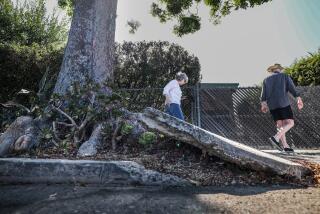Burbs Need to Step Up in Cleanup of Skid Row
- Share via
The cluster of portable toilets, once a thriving brothel and occasional crash pad, is gone from the corner of Sixth and San Julian streets in downtown Los Angeles. So ends the skid row story of a john in every john, at least at that location.
No more T.J. (Thick and Juicy) and T.T. (Tall and Tiny) plying their trade.
No more drug-dealing in the johns while passers-by relieve themselves behind the toilets.
No more bodies dragged out and shipped to the morgue.
I noticed the change a few weeks ago. Capt. Andrew Smith of the LAPD says publicity about the prostitution and drug-dealing helped create the political will to do what he’d wanted to do for months, and shelters are helping out by opening their restrooms to one and all. The potties at Third and Main also got the heave-ho from the authorities, as did the ones at Seventh and Wall.
Officer Deon Joseph said he sees T.T. on the streets now and then, and he’s trying to get her into temporary housing at a downtown hotel. He saw T.J. recently but doesn’t know if she’s still working or living in the area.
I couldn’t find either of the women. My guess is that neither is thrilled about the demise of their corner operation, but like other recent developments on skid row, it’s a step in the right direction.
Yes, it’s shocking that public officials had to be shamed into addressing a festering disgrace just blocks from City Hall. But publicity about the horrors of skid row and the indiscriminate dumping of mentally and physically ill people by police agencies and hospitals -- as alleged by Capt. Smith -- appears to have done the trick.
In the sudden flurry of political flexing, plans call for the installation of surveillance cameras to scare off predators and increased penalties for peddling drugs near treatment and recovery centers.
State Sen. Gil Cedillo wants to explore the possibility of a skid row court focused on the intersection of crime and mental health issues. Such a court would take advantage of Proposition 63 funding for mental health services and link people with appropriate programs rather than just churn them back onto the street.
And Cedillo and Assembly Speaker Fabian Nunez -- both of whom live in downtown Los Angeles -- are pitching legislation to deliver released inmates back to the communities where they were arrested, ending the practice of tossing them into the fray on skid row.
“Community reunification,” Cedillo called it, saying that of the roughly 186,000 people released from county jail last year, 50,000 ended up on skid row. “We’ve got to cut off that spigot.”
This concept, naturally, has led to fear and loathing in the outer reaches.
“This is a plan for balkanization of the region,” complained Calabasas Mayor Barry Groveman.
“A redistribution of resources is not going to be easy to achieve,” whined Pasadena Mayor Bill Bogaard.
“I am not sure that would be the kind of solution folks in the local cities would approve of,” cried Montebello Mayor William Molinari.
Blah, blah, blah.
Yes, there’s a concentration of services on skid row, so to some degree it has made sense to use downtown L.A. as a catch-all and clearinghouse. But with all its festering problems, skid row is a trap as well as a solution, and it’s time to admit that what’s needed is far more services in far more places.
“I think we can make a significant dent in the problem on skid row if we make people in the region take responsibility,” said Los Angeles City Councilwoman Jan Perry.
I happened to be in Capt. Smith’s office Tuesday morning while he talked strategy with his skid row team. Gang members, he said, are paying day laborers $40 a day to sell drugs -- a business plan that’s proved so successful that now gangs are streaming in from all over the area to grab a piece of the heroin and rock cocaine trade.
The cops use uniformed and undercover officers to break up the action, even as Smith tries to cut off the volume of dealers and customers by blowing the whistle on dumping. He asked if I thought there was anything else they could be doing.
Yes, I said. Get a jump-start on the community reunification program. Use squad cars, taxis and buses to send some of the problems back where they came from.
Skid row exists in part because we can’t summon the will to create better schools, affordable housing, universal healthcare, jobs that pay a living wage, and humane treatment of people tormented by mental illness. Then, on top of that, we want the impact of our indifference to be kept out of sight. Let somebody else worry about it.
Last year, to cite a perfect example, Santa Clarita officials decided they’d rather pay to bus homeless people to Los Angeles than run a shelter. They finally relented under pressure. This year, residents of Castaic had fits over a proposal to put a winter shelter in the parking lot of -- are you ready for this? -- a jail.
The angry hordes might have been justified if the proposal was for a shelter next to an elementary school, or in the rolling greenery of a tidy residential area.
But next to a jail?
I say we send a couple of buses up from skid row to talk it over at the next Castaic Town Hall meeting. And don’t worry about the crowds, Castaic. The LAPD has some portable toilets we can bring along.
Reach the columnist at [email protected] and read previous columns at www.latimes.com/lopez.
More to Read
Sign up for Essential California
The most important California stories and recommendations in your inbox every morning.
You may occasionally receive promotional content from the Los Angeles Times.











